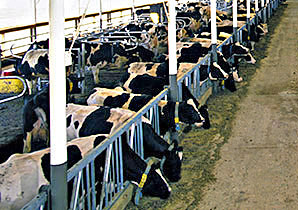This page has been archived and is being provided for reference purposes only. The page is no longer being updated, and therefore, links on the page may be invalid.
Phosphorus Leaching Differs in Dairy Manures
By Ann PerryMay 28, 2009
Agricultural Research Service (ARS) scientists have found that solid dairy manure is better than commercial fertilizer in mitigating the amount of phosphorus that can accumulate in water percolating through the soil. But using liquid dairy manure can make it worse.
These findings could help farmers in the semiarid western United States protect local watersheds from agricultural pollutants. Idaho is now the second-largest milk producer in the western United States, and farmers there are using substantial amounts of dairy manure for fertilizing irrigated crop fields. Phosphorus can fuel the excessive growth of algae and other plant matter in freshwater ecosystems.
ARS soil scientists David Tarkalson and April Leytem used manure they obtained from two dairy farms in Idaho to study phosphorus leaching in the fine sandy loam soils typically found in the region. In laboratory tests they amended 24 soil columns with either liquid dairy manure, solid dairy manure or monoammonium phosphate (MAP), a commercial fertilizer.
Then the researchers "irrigated" the soil columns 13 times over nine weeks and collected the leachate-the liquid that drained out of the soil, carrying substances picked up along the way-from each irrigation event. The leachate was analyzed for total organic carbon and total phosphorus. After the irrigation testing, they also analyzed the soil in each column for phosphorus, carbon, calcium, iron and manganese.
Tarkalson and Leytem found that the largest quantities of phosphorus moved through soils that had been amended with liquid manure. They also found that the phosphorus in MAP was more mobile in the soil than phosphorus in the solid manures.
The scientists also observed that liquid manure and solid manure differed significantly in their carbon compound makeup, which may contribute to the resulting variations in the manure leachates. Other factors may also play a part in the dynamics of phosphorus leaching, including microbial activity and metal content in the soil and the ability of clay particles in the soil to attract and hold onto phosphorus.
Tarkalson and Leytem work at the ARS Northwest Irrigation and Soils Research Laboratory in Kimberly, Idaho.
ARS is the principal intramural scientific research agency of the U.S. Department of Agriculture.

